Whether you are a parent or not, most of us are at least passingly familiar with the time and preparation that goes into bringing home a new baby. Parents-to-be build a nursery and stock up on supplies that their new baby will need. Getting a puppy is admittedly a bit different, but one thing remains the same – if you’re bringing home a new family member, you’re going to need to do some preparation! Here is our list of supplies and puppy-proofing to prepare your home for your new puppy. Don’t forget to scroll to the bottom for our printable checklist!
Supplies
Even if you have owned a dog in the past or currently own an adult dog, we advise you give this list a quick look. Adult dogs have different needs than puppies, and we want to be sure that you and your new puppy are comfortable and safe.
Essentials
Food
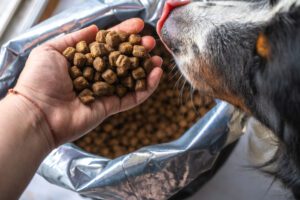
Your puppy’s food will be the foundation for their health. A balanced diet high in protein and enriched with plenty of vitamins will help your puppy’s body grow strong. We recommend Earthblend Dog Food, a premium dog food formulated for all ages and all breeds. Regardless of which food you choose, have enough food in your home to make sure your puppy is never going hungry!
Water and Food Bowl
Unless you’re prepared to sacrifice your own bowls for your puppy, your new furry friend will need some dishes for food and water. Consistent access to clean water is especially essential living in the desert. Choose a bowl that is easy to clean and is an appropriate size for your puppy’s breed.
See also: Though we recommend owning a bowl, handfeeding can be an excellent way for meal time to double as training time. Check out our guide to handfeeding your puppy.
Leash and Collar
It’s a big, beautiful world out there, and your puppy will need a leash and collar to explore! While we would recommend preparing most of your puppy’s supplies before they get home if possible, a collar may be better purchased with your dog in front of you to ensure you choose something that fits them. A rule of thumb for choosing the right collar is that you should be able to fit two fingers between the collar and your dog’s neck. Your Puppy Specialist can assist you in finding a snug and secure fit. Your dog’s collar should also contain your identification information. If you are ever in a situation where your puppy is lost, having both the outer identification tags and their microchip increase the likelihood that they will find their way home.
What about harnesses?
Harnesses do offer an extra level of security and control while walking, but there are also a few drawbacks. A puppy can learn to pull hard while wearing a harness, and they are able to exert considerably more force with a harness! A harness should also not be left on your puppy. If you choose to get your puppy a harness, we recommend training them on a leash and collar first, and also having your puppy always wear their collar with their identification.
Crate
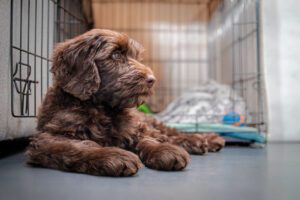
A crate is many things to your dog; it is a potty training tool, it is their sleeping area, it is their safe space. We cannot sing the praises of crate training enough. Even if you already have an available crate in your home, put some thought into keeping a crate for different rooms in your home. This gives your puppy a secure place to retreat to when they are in need of some peace and quiet!
Poop Bags
We won’t sugarcoat it – puppies poop… a lot! Poop bags allow you to swiftly and efficiently deal with the mess.
Treats
Treats are for more than just telling your beloved puppy how much you love them; they are an important tool for training. Keep a supply of high-quality, high-value treats on hand to reward your puppy for good behavior!
Brush
How urgently your dog needs a brush depends on their breed and coat type. Long-haired dogs, double-coated breeds, doodle mixes, or hypoallergenic dogs need to be regularly brushed. Dogs with short bristly hair such as pugs or bulldogs do not require frequent grooming, but may benefit from being brushed to reduce shedding and keep their coats healthy. Introducing your puppy to grooming early will make the process much easier as they grow into adulthood.
Toys
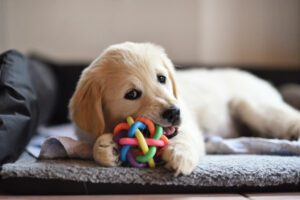
Puppies love to play! Aside from keeping your puppy entertained and giving them something to cuddle up to, toys are essential during the puppy teething phase. When your puppy starts to gnaw on one of your belongings (or on you!) then use the toy to redirect their attention. Remember to choose a toy that is size-appropriate for your puppy’s breed!
Beds
Everyone deserves a comfy spot to rest their head after a long day. Don’t forget to get your puppy a cozy bed of their own!
Recommended Additional Supplies
Odor/Stain Remover
While you may be optimistic about potty training, expecting your puppy to never have an accident in the house is a lot of pressure on you both! In the event of an accident, be sure that your cleaning supplies not only sterilize the spot but break down the enzymes. This keeps your puppy from smelling past accidents and assuming that this is an appropriate place to relieve themselves!
Exercise Pens or Baby Gates
If there are certain areas in your home that are off-limits to your puppy, you’ll want an exercise pen or baby gate to keep them out. Even if you intend to eventually give your puppy free run of the house, starting them off in a smaller area and gradually giving them more freedom allows you both a less chaotic introduction to the home.
Shampoo
Puppies have a remarkable knack for making a mess, including making a mess of themselves! Keep your puppy looking and smelling clean with some dog-friendly shampoo.
Toothbrush and Toothpaste
Brushing your dog’s teeth has significant health benefits! Regular brushings can prevent serious dental problems and costly surgery in the future. Similarly to hair brushing, acclimating your puppy to regular teeth brushing while they are young will be very helpful for the future.
Backpack/Stroller
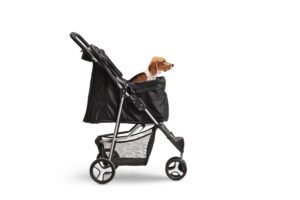
The first few months of a puppy’s life are critical for socialization, but socialization must be tempered with caution before they have had all their shots. A great way to both reduce your puppy’s exposure to potential illness and allow them to have novel experiences is with a puppy backpack or stroller.
Enrichment Toys
Enrichment toys are different from simple chew toys or stuffed toys. Dogs are extremely intelligent and sensitive creatures. Enrichment toys engage their brains and help to stave off boredom!
Pee Pads
Pee pads are a bit of a mixed bag. On the one hand, some people swear by pee pads, and some dogs only use pee pads for their whole lives. On the other hand, use of pee pads does make training your puppy to go to the bathroom outside more difficult because it teaches them that relieving themselves inside is acceptable. If your long-term goal is to have your puppy go to the bathroom outside only, pee pads may not be the right choice for you. A word of warning: whatever you do, do not place a pee pad in their crate! The last thing that you want to do is to teach them to soil their crate!
Puppy-proofing
The previous section supplies that you need to add to your household to make it comfortable for your new puppy. What about making your home safe for your new best friend? Puppy-proofing your home is key, for the sake of your puppy (and possibly, your sanity!) Here are some potential hazards to watch for:
Electrical Cords
Electrical cords are one of the most common hazards for a curious young puppy. Secure any electrical cords out of reach of the puppy. If this is not possible, use cable wrap, PVC pipe, or other protective covers to keep your cords safe from little teeth.
Toxic Plants
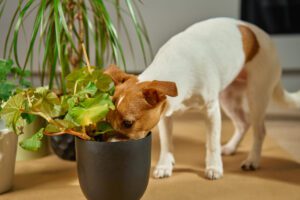
A surprising number of common houseplants are toxic to dogs. Move any of these plants out of reach of your puppy, or rehome them to another plant lover. Don’t worry – there are plenty of pet-friendly plants out there!
Household Chemicals & Medications
Make sure that all medications, household chemicals, detergents, and essential oils are out of reach of the puppy. If they are stored in cabinets that are eye-level for your puppy, consider installing child locks or moving them to a different spot. Make sure that even over-the-counter medications and vitamins are put away.
Food
What is good for humans is not always good for puppies! Among other things, common foods like onions, grapes, chocolate, and coffee are poisonous to puppies. Xylitol, a low-calorie sweetener, is often found in toothpaste, sugar free gum, or certain types of peanut butter. Make sure all food is shut away where your puppy cannot go on a feeding spree while your back is turned.
Trash Cans
Humans would never dream of eating out of the trash can; puppies have no such qualms. Make sure that all trash cans have lids, and consider securing them to keep the puppy from knocking them over. If you have cats, keep litter boxes clean and if possible move to a location that the puppy cannot access to keep them for “hunting for treasure”. (We love puppies, but even we can admit, sometimes they can be a little gross!)
Clothing
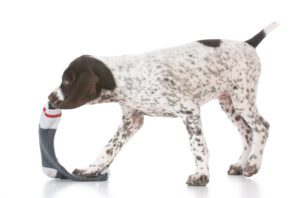
All laundry should be stored away in laundry baskets. Laundry left on the floor, such as socks or underwear, could be torn up or even swallowed!
Water
Bathtubs should be empty when not in active use, and keep toilet lids closed. This both protects your dog from drowning, and you won’t have to break a habit of them drinking from the toilet! If you have a pool, a dog should NEVER be allowed near the pool unsupervised, and we strongly recommend installing a barrier around the pool. See this article for additional advice about setting up your yard for your puppy.
Stairs
Believe it or not, yes, puppies can fall down the stairs just like people. If you have stairs in your house, block them off when you’re not around with a baby gate. Consider installing non-slip surfaces. If your stairs are open-back or you have a railing that your puppy can fit their head through, cover these areas with mesh. Note: It is important that your puppy is exposed to and learns how to use the stairs while they are young. Just make sure that they have proper supervision.
Small Spaces
Check around your house for small spaces. You might be surprised at how many spots could fit a crafty puppy! Some common examples are in the bathroom behind the toilet, in between cabinets, or the backs of recliners. Seal these areas off or block them with an object. This could save your puppy from injury… or possibly a very embarrassing call to the fire department to say “my puppy is stuck behind the toilet!”
Containers
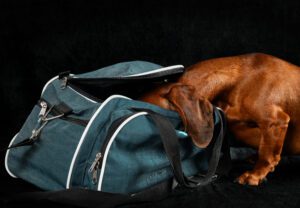
Purses, grocery bags, briefcases, or other containers should not be kept off the ground. You’ll be amazed at how quickly your puppy can have these open and go rooting around!
Small Objects
Objects such as loose change, paperclips, rubber bands, dental floss, or jewelry can be especially dangerous to your puppy if they are ingested! Routinely scan to make sure that none of these have ended up within the puppy’s reach.
Anything that’s not nailed down…
Remember that your puppy is still a baby! They are still exploring the world, and their primary method of doing that is by chewing on them. They don’t know the rules yet of your home, and many of them are still teething. If is within your puppy’s reach and will fit in their mouth, it’s fair game! Starting off in a small area and gradually allowing your puppy more freedom will allow you both to adjust. Start reinforcing the behavior you want to see right away. If you see your puppy chewing on something that they should not, redirect them to a toy. If they go to chew on their toy on their own, give them a treat. With time, training, and maturity, you will be able to lower your restrictions in your home.
Printable Puppy Supply Checklist
Printable Puppy Proofing Checklist
Up next: You’ve tackled the physical, but what about mental preparation? Learn about what to plan before your puppy gets home here!



